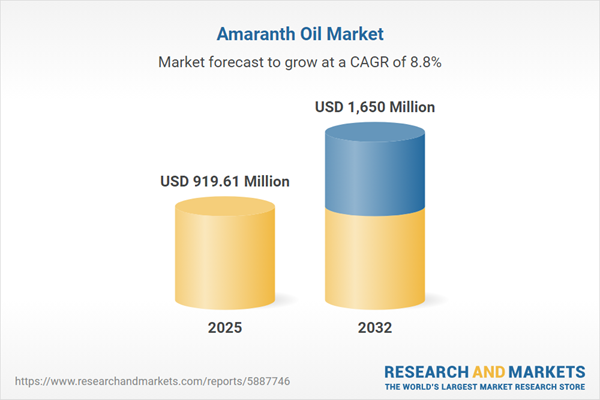Speak directly to the analyst to clarify any post sales queries you may have.
The amaranth oil market is entering a transformative phase, shaped by shifts in sustainability practices, evolving technology, and new buyer demands. For senior decision-makers, proactively adapting to these trends and aligning organizational strategies is essential to stay competitive in a rapidly changing environment.
Amaranth Oil Market Snapshot
The global amaranth oil market reached USD 844.57 million in 2024 and is projected to expand to USD 919.61 million in 2025, with future estimates targeting USD 1.65 billion by 2032, corresponding to a CAGR of 8.77%. This growth trajectory is underpinned by consistent demand from cosmetics, food, nutraceutical, and pharmaceutical applications. Industry players are strengthening clean label portfolios, emphasizing responsible sourcing, and enhancing product quality to meet escalating standards. The market landscape is witnessing increased activity from established and emerging participants, stimulating competition and accelerating technology integration throughout the supply chain.
Scope & Segmentation of the Amaranth Oil Market
- Application: Amaranth oil is incorporated into cosmetics, supporting skin hydration and antioxidant-related benefits; utilized in food and nutraceutical sectors for enrichment and nutritional fortification; and employed by the pharmaceutical industry as a functional carrier oil in diverse formulations.
- Product Form: Refined variants offer higher purity and longer shelf life for applications requiring stable formulations, while unrefined oils deliver more native phytonutrients, aligning with end-user and regulatory needs targeting specific product profiles.
- Distribution Channel: Companies leverage various procurement routes, including direct B2B sales, authorized distributors, hypermarkets, supermarkets, digital retail platforms, and specialty store outlets to address the full spectrum of commercial acquisition strategies.
- Source: Sourcing from Amaranthus Caudatus, Amaranthus Cruentus, and Amaranthus Hypochondriacus is crucial for maintaining product consistency, achieving desired yields, and targeting differentiated segments within the market.
- Geographic Coverage: Market dynamics are tracked across the Americas—encompassing North, Central, and South America—EMEA (covering Western and Eastern Europe, the Middle East, and Africa), and Asia-Pacific, including East, South, and Southeast Asia and Oceania. This broad oversight ensures robust benchmarks for competition and supply chain efficiency in each region.
- Companies Analyzed: This research features Connoils India Private Limited, Hunan Anbang Pharmaceutical Co., Ltd., Brothers Energy Ingredients Private Limited, Sabinsa Corporation, Akay Natural Ingredients (P) Limited, Naturalin Bio-Resources Co., Ltd., Planeteers (UK) Limited, BioHarvest Biotech LLC, NOREVO GmbH, and Ruiteng (Beijing) Biotechnology Co., Ltd., offering a comprehensive competitive review.
Key Takeaways for Strategic Decision-Makers
- Bioactive profiles and polyunsaturated content are encouraging the introduction of advanced cosmetics and nutrition solutions, spurring active innovation in specialized product ranges.
- Transparent, ethically managed supply chains are increasingly regarded as vital, helping to strengthen buyer confidence and support corporate responsibility programs.
- Sustainable extraction technologies, such as supercritical CO₂ processing, provide reliable quality control and align with cost management and compliance objectives.
- Collaborative initiatives between suppliers, technology providers, and R&D institutions are accelerating the pace of innovation, translating research advancements into market-ready products.
- Securing a competitive advantage often depends on selecting optimum cultivars and fine-tuning development to meet the purity and performance expectations of specific industries and end-users.
Tariff Impact: 2025 U.S. Duties and Global Supply Chains
Forthcoming changes to U.S. tariffs in 2025 are prompting market participants to re-examine sourcing frameworks. Many organizations are increasing their reliance on suppliers in Latin America and Asia-Pacific, while upgrading inventory management systems to navigate potential volatility. In the United States, investments in local infrastructure are aimed at boosting supply chain agility and responsiveness. At the same time, efforts to broaden sourcing and enhance logistics are designed to minimize exposure to regulatory changes and supply disruptions, supporting continuous market access in a dynamic regulatory environment.
Methodology & Data Sources
This market intelligence is built on rigorous secondary research, targeted interviews with senior sector leaders, structured industry surveys, and a triangulated validation process. These steps ensure reliable and actionable insights to guide strategic planning and operational decisions for the amaranth oil market.
Why This Report Matters
- Enables executives to benchmark supplier practices and monitor high-impact shifts affecting product development and procurement.
- Equips procurement teams to anticipate regulatory adjustments and manage risks within increasingly complex supply chains.
- Delivers actionable segmentation and market guidance, supporting sound investment and expansion strategies in key end-use and geographic segments.
Conclusion
The amaranth oil market is at a pivotal moment defined by innovation, collaborative progress, and a heightened focus on sustainability. Leaders who prioritize these areas are positioned to adapt, capitalize on new opportunities, and navigate sector evolution with confidence.
Additional Product Information:
- Purchase of this report includes 1 year online access with quarterly updates.
- This report can be updated on request. Please contact our Customer Experience team using the Ask a Question widget on our website.
Table of Contents
3. Executive Summary
4. Market Overview
7. Cumulative Impact of Artificial Intelligence 2025
List of Figures
Samples

LOADING...
Companies Mentioned
The key companies profiled in this Amaranth Oil market report include:- Connoils India Private Limited
- Hunan Anbang Pharmaceutical Co., Ltd.
- Brothers Energy Ingredients Private Limited
- Sabinsa Corporation
- Akay Natural Ingredients (P) Limited
- Naturalin Bio-Resources Co., Ltd.
- Planeteers (UK) Limited
- BioHarvest Biotech LLC
- NOREVO GmbH
- Ruiteng (Beijing) Biotechnology Co., Ltd.
Table Information
| Report Attribute | Details |
|---|---|
| No. of Pages | 186 |
| Published | October 2025 |
| Forecast Period | 2025 - 2032 |
| Estimated Market Value ( USD | $ 919.61 Million |
| Forecasted Market Value ( USD | $ 1650 Million |
| Compound Annual Growth Rate | 8.7% |
| Regions Covered | Global |
| No. of Companies Mentioned | 11 |









